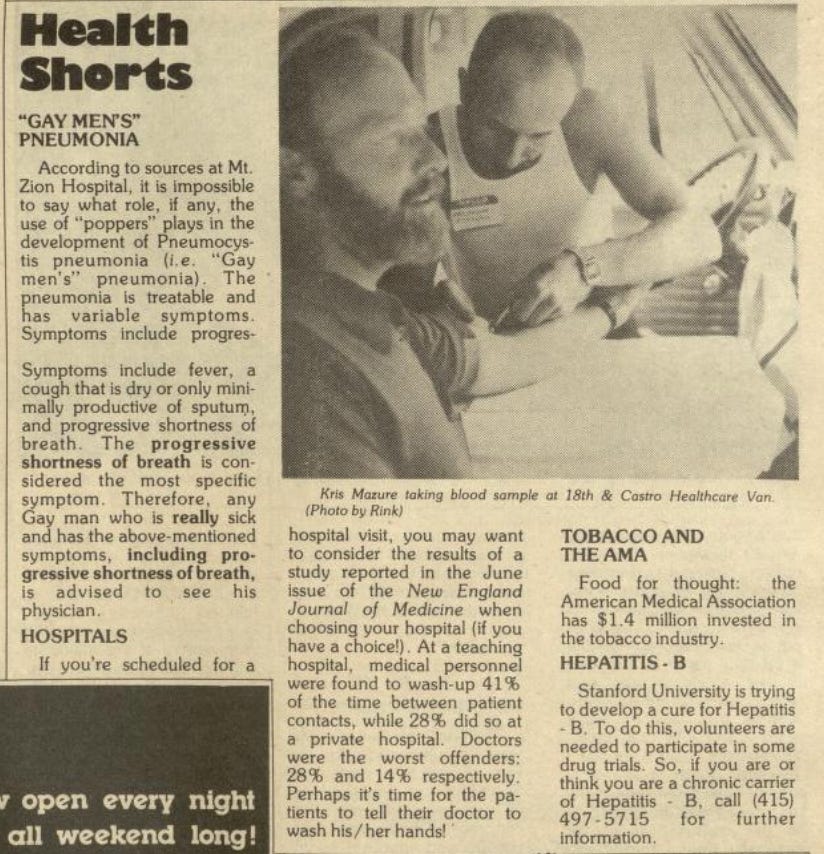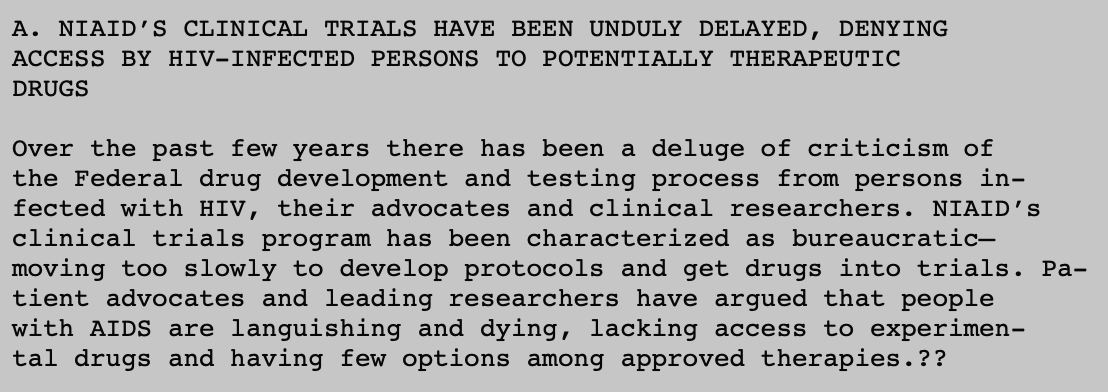Evidence continues to mount that the coronavirus originated in the Wuhan Institute of Virology. It’s been revealed that Anthony Fauci funneled taxpayer dollars to the lab that was conducting the Chinese government’s dangerous gain-of-function research. Fauci’s behind-the-scenes efforts to change the narrative on the origin of the coronavirus are slowly being disclosed.
This isn’t the first time Fauci was behind a colossal blunder. Four decades ago, his not-so-subtle efforts to blame gays for spreading AIDS by surface contact fueled the scare that the virus could be contracted from pay phones, toilet seats, and doorknobs, and led to a spike in anti-gay violence.
An earlier version of this column was first published about a year ago. This update includes more detail to counter the Fauci apologists who insist Fauci had nothing to do with the you-can-get-AIDS-from-surface-contact debacle.
As we witnessed with the COVID-19 pandemic, the onset of the AIDS epidemic caused widespread panic. It was especially tragic in the early days when, like with the coronavirus, there were unanswered questions about the virus’s origin and the manner in which it could spread. Initial reports found nearly all who contracted AIDS (acquired immune deficiency syndrome) were homosexual men, intravenous drug users, hemophiliacs, and Haitians. About 700,000 Americans have died from AIDS since the disease was first reported four decades ago.
In the early 1980s, there were sporadic reports about a serious flu-like illness affecting otherwise healthy, young gay men. There were also reports of young men dying from a rare form of cancer called Kaposi’s sarcoma. A handful of doctors and researchers were trying to piece together what led to the illness. It was the Centers for Disease Control (CDC) that introduced to the general public the existence of the virus that eventually came to be known as AIDS.

Centers for Disease Control Morbidity and Mortality Weekly, June 1981
In June 1981, the CDC published a column in its Morbidity and Mortality Weekly Report reporting five young men had been treated in Los Angeles hospitals for Pneumocystis carinii pneumonia, an infection that usually afflicts immunosuppressed patients. Two of the five patients died. The CDC reported, “[t]he fact that these patients were all homosexuals suggests an association between some aspect of a homosexual lifestyle or disease acquired through sexual contact.”

Bay Area Reporter reporting “gay men’s” pneumonia, July 2, 1981
That same July, the New York Times reported 41 homosexual men had been diagnosed with Kaposi’s sarcoma and that one doctor who had treated nine of the patients “found severe defects in their immunological systems.”
In an article titled “New Homosexual Disorder Worries Health Officials” published the following May, the New York Times reported a disorder it called “GRID, for gay-related immunodeficiency.” By then, the die had been cast. Reporting by the New York Times and elsewhere left much of the public with the impression this was a disease that mostly affected the gay community.

New York Times reporting “New Homosexual Disorder,” May 11, 1982
AIDS quickly became a topic of public conversation. It was referred to as GRID, gay flu, gay plague, and similar names. The illness, most people believed, was confined to gay men, intravenous drug users, and Haitians. A joke making the rounds asked, “What is the most difficult thing about getting AIDS?” “Convincing your parents you are Haitian,” was the punchline.
In the May 6, 1983 issue of the Journal of the American Medical Association (JAMA), a pair of articles discussed possible transmission scenarios of AIDS. “Immune Deficiency Syndrome in Children,” authored by James Oleske, MD, MPH, and others, focused on eight Newark, NJ children who were born into families “with recognized risks for AIDS.” Four of the eight infants died.
The paper’s comments section had this conclusion:
It is difficult for us to conclude that we and others have simultaneously experienced a sudden upsurge in congenital immune defects or congenital viral infections of the usual type. It seems more plausible to us that the illnesses in these youngsters were related in some way to household exposure.
Further, the Oleske article conjectured that some type of contact with infected patients may have contributed to the spread and “that sexual contact or drug abuse is not required for transmission” of the virus.
The second article published in the JAMA reached a different conclusion regarding transmissibility. Arye Rubinstein, MD, and others authored “Acquired Immunodeficiency With Reversed T4/T8 Ratios in Infants Born to Promiscuous and Drug-Addicted Mothers.” The article reviewed the cases of “seven children who were small for gestational age at birth and subsequently have exhibited a failure to thrive, lymphadenopathy, parotitis, hepatosplenomegaly, interstitial pneumonia, and recurrent infections.”
The mothers appeared to either have had multiple sex partners or were intravenous drug addicts, a pair of high-risk categories for developing AIDS. Rubinstein and his fellow authors surmised it was very likely the infants contracted the virus during the mothers’ pregnancies; a fact well-understood today.
A third article appeared in the same JAMA issue. It was an editorial written by Anthony Fauci, MD, a senior official with the National Institutes of Health. Fauci warned, “Perhaps even more important is the possibility that routine close contact, as within a family household, can spread the disease.” At the time, there was uncertainty about how the virus was being transferred from patient to patient, but there was no evidence people were contracting the virus from contaminated surfaces, as Fauci was suggesting. But the damage was done. Fauci’s editorial launched a wave of public hysteria that received widespread media play.

Fauci paper falsely warning of surface contact transmission, May 6, 1983
Arye Rubinstein was astounded that Anthony Fauci could be so stupid as to say that household contact might have anything to do with spreading AIDS. Rubinstein had never been a great admirer of New Jersey’s Dr. Oleske; they had antithetical views of AIDS in children. To Rubinstein, the mode of transmission was fairly obvious and fit quite well with existing epidemiological data on AIDS. The mother obviously infected the child in her womb. The fetus and parent shared blood as surely as an intravenous drug user, hemophiliac or blood transfusion recipient. The fact that none of the infants in Oleske’s study were over one year old reinforced this notion.
What was Fauci’s problem?
Upon investigation, Rubinstein learned that Anthony Fauci had not bothered to read his paper before writing the JAMA editorial. Instead, he just read Oleske’s conclusions and started running off at the mouth.
Fauci had been chief of the National Institutes of Health (NIH) Laboratory of Immunoregulation since 1980. He would be promoted to director of the National Institute of Allergy and Infectious Diseases (NIAID) in 1984, a position he held through 2022. In May 1983, Fauci was the highest-ranking US health official to start flogging the wild claim AIDS could be contracted from common surfaces.
Four weeks after his JAMA article appeared, Oleske clarified the transmission risks stating, “Casual everyday contact is okay. You don’t get it from the air, a plate, a glass.” Oleske was trying to minimize hysterical reactions to the surface contact theory. Meanwhile, Fauci continued pushing his baseless claim.
After his editorial appeared, Fauci embarked on a press junket warning the public AIDS could possibly be caught by touching common objects. United Press International quoted Fauci, “The finding of AIDS in infants and children who are household contacts of patients with AIDS or persons with risks for AIDS has enormous implications with regard to ultimate transmissibility of this syndrome.”
Fauci told ABC News, “If the close contact of a child is a household contact perhaps there will be a certain number of cases of individuals who are just living with, and in close contact with, someone with AIDS, or the risk of AIDS, who does not necessarily have to have intimate sexual contact or share a needle but, just the ordinary contact one sees in normal interpersonal relations.”
In 2011, former US Surgeon General C. Everett Koop, MD, ScD, reminisced about the early days of HIV (human immunodeficiency virus). Koop noted Fauci was actively promoting the unfounded surface contact theory. Koop wrote, “Tony Fauci, Director of AIDS Research at NIH, insisted we check out any study that didn’t seem to rule out the spread of AIDS by casual contact.” Koop lumped Fauci’s theory into a category of “all kinds of unsubstantiated claims about mosquitoes and toilet seats.”

Dr. C. Everrett Koop’s 2011 recollection of Fauci promoting false surface contact theory
Anthony Fauci was the one-man band who heavily promoted the fact-less AIDS-from-surface-contact theory. Others in the medical and scientific communities who reported there was no evidence to support Fauci’s claims had their voices drowned out. Fauci was everywhere in the press. Media outlets gave widespread coverage to Fauci and his false theory.
A National AIDS forum was held in Denver in June 1983 to counter growing discrimination against gays over the virus and to push back against Fauci’s claim it could be spread by daily contact. The forum’s statement titled “Denver Principles” included as its very first statement, “available evidence does not support the view that AIDS can be spread by casual, social contact.”

The Denver Principles 1983
The ugly rumors that AIDS could be passed from person to person by an act as simple as a handshake came during a vulnerable time for the gay community. Widespread public acceptance of homosexuals was still in its infancy around the beginning of the AIDS epidemic. Scare stories persisted that AIDS could be caught by touching the same door knobs, telephones, and public restrooms that were used by someone infected with AIDS.
An immediate spike in discrimination against gays and hate crimes targeting homosexual men and women occurred as Fauci’s misinformation over transmissibility spread. The US Justice Department reported fear of AIDS as a contributing factor in the increase of anti-gay violence. Families were broken up, and AIDS patients were being isolated over contagion worries.
Gallup reported a few years later that 3 in 5 Americans wanted people with AIDS to carry a card announcing they were infected. One in three respondents to Gallup believed employers should be able to fire AIDS-infected workers.
As AIDS began taking a growing number of lives, it appeared AIDS research was moving at a snail’s pace. Some of the delays in federal AIDS efforts may have been due by the belief the virus was confined to the gay community. As the head of AIDS research for the NIH, Fauci admitted in late 1986, “The disease didn’t at first get the attention it deserved to have gotten.”
Shockingly, Fauci wasn’t willing to assign an employee to work full-time on finding a cure for AIDS even as the disease was spreading. He also blamed drug sourcing, a sluggish bureaucracy, and uncertainty on testing procedures as some of the reasons for his department’s delays in launching drug evaluations.
The House Committee on Government Operations gave Fauci a poor report card. In its report to the entire House of Representatives, it stated “the committee believes NIAID’s current efforts have failed to meet one of its primary goals to ‘transfer timely information to guide physicians in selecting the most appropriate therapy’ for their HIV infected patients.”

House Report 100-1092 critical of Fauci’s efforts in AIDS research
Fauci’s key role in federal AIDS research was not lost on some in the gay community. In a profanity-laced Village Voice open letter published on May 31, 1988, activist Larry Kramer blasted Fauci as “an incompetent idiot.” Kramer co-founded the Gay Men’s Health Crisis, one of the nation’s first non-profits dedicated to raising money for AIDS research. Kramer’s chief complaint was Fauci accomplished nothing in four years despite sitting on a budget that Kramer insisted was $374 million. In his letter, Kramer noted that nearly half the 24 drugs identified for possible AIDS treatment had not been entered into trials.

“An Open Letter to Dr. Anthony Fauci” by Larry Kramer, May 31, 1988
Kramer was way off on his number of $374 million, as it only represented about one year of NIAID appropriations. Between Fauci’s November 2, 1984 appointment as the director, of the National Institute of Allergies and Infectious Diseases and when he was called before Congress in 1988, the agency received a whopping $1.8 billion in federal appropriations. Over the seven fiscal year period, NIAID received $274 million (FY-83), $306 million (FY-84), $371 million (FY-85), $384 million (FY-86), $384 million (FY-87 CR), and $384 million (FY-88 CR).





NIAID appropriations for fiscal years 1983, 1984, 1985, 1986 & 1989
In the fiscal year 1989, Fauci’s NIAID saw its appropriations more than double to a staggering $754 million. Lack of money did not appear to be the hold-up Fauci claimed it was. At the same time, there were significant funding cutbacks throughout the federal government, NIAID received nearly a 36% increase in funding between fiscal years 1983 and 1985. Compared to most other federal agencies, Fauci’s NIAID was flush with cash.
The non-profit AIDS Coalition To Unleash Power (ACT UP) was founded in New York in 1987 to put pressure on what it called the “negligence” and “complacency” of NIH and other government and medical organizations. ACT UP did not observe a sense of urgency in federal health efforts to stem the spread of AIDS, and to find a cure.
Today, an estimated 1.2 million people in the US are living with HIV, the virus that causes AIDS.
Mark Hyman is an Emmy award-winning investigative journalist. Follow him on Twitter, Gettr, Parler, Post, and Mastodon.world at @markhyman, and on Truth Social at @markhyman81.

